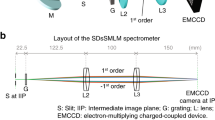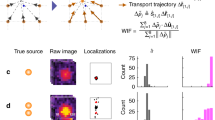Abstract
Single-molecule localization microscopy (SMLM) leverages the power of modern optics to unleash ultra-precise structural nanoscopy of complex biological machines in their native environments as well as ultra-sensitive and high-throughput medical diagnostics with the sensitivity of a single molecule. To achieve this remarkable speed and resolution, SMLM setups are either built by research laboratories with strong expertise in optical engineering or commercially sold at a hefty price tag. The inaccessibility of SMLM to life scientists for technical or financial reasons is detrimental to the progress of biological and biomedical discoveries reliant on super-resolution imaging. In this work, we present the NanoPro, an economic, high-throughput, high-quality and easy-to-assemble SMLM for super-resolution imaging. We show that our instrument performs similarly to the most expensive, best-in-class commercial microscopes and rivals existing open-source microscopes at a lower price and construction complexity. To facilitate its wide adoption, we compiled a step-by-step protocol, accompanied by extensive illustrations, to aid inexperienced researchers in constructing the NanoPro as well as assessing its performance by imaging ground-truth samples as small as 20 nm. The detailed visual instructions make it possible for students with little expertise in microscopy engineering to construct, validate and use the NanoPro in <1 week, provided that all components are available.
This is a preview of subscription content, access via your institution
Access options
Access Nature and 54 other Nature Portfolio journals
Get Nature+, our best-value online-access subscription
$29.99 / 30 days
cancel any time
Subscribe to this journal
Receive 12 print issues and online access
$259.00 per year
only $21.58 per issue
Buy this article
- Purchase on Springer Link
- Instant access to full article PDF
Prices may be subject to local taxes which are calculated during checkout





Similar content being viewed by others
Data availability
The datasets generated during and/or analyzed during the current study are available from the corresponding author on reasonable request.
Code availability
Updated versions of the source code for NanoPro 1.0, as well as guiding instructions (visual assembly, alignment and operation guides and instructional videos), can be obtained from https://github.com/jdanial/NanoPro and are archived in Zenodo48. A compilation of NanoPro 1.0 for the Windows operating system is available in the GitHub repository.
Change history
27 September 2023
A Correction to this paper has been published: https://doi.org/10.1038/s41596-023-00909-5
References
Szymborska, A. et al. Nuclear pore scaffold structure analyzed by super-resolution microscopy and particle averaging. Science 341, 655–658 (2013).
Salvador-Gallego, R. et al. Bax assembly into rings and arcs in apoptotic mitochondria is linked to membrane pores. EMBO J. 35, 389–401 (2016).
Mund, M. et al. Systematic nanoscale analysis of endocytosis links efficient vesicle formation to patterned actin nucleation. Cell 174, 884–896.e17 (2018).
Rust, M. J., Bates, M. & Zhuang, X. Sub-diffraction-limit imaging by stochastic optical reconstruction microscopy (STORM). Nat. Methods 3, 793–796 (2006).
Huang, B., Wang, W., Bates, M. & Zhuang, X. Three-dimensional super-resolution imaging by stochastic optical reconstruction microscopy. Science 319, 810–813 (2008).
Betzig, E. et al. Imaging intracellular fluorescent proteins at nanometer resolution. Science 313, 1642–1645 (2006).
Jungmann, R. et al. Multiplexed 3D cellular super-resolution imaging with DNA-PAINT and Exchange-PAINT. Nat. Methods 11, 313–318 (2014).
Xu, K., Zhong, G. & Zhuang, X. Actin, spectrin, and associated proteins form a periodic cytoskeletal structure in axons. Science 339, 452–456 (2013).
Ries, J. et al. Superresolution imaging of amyloid fibrils with binding-activated probes. ACS Chem. Neurosci. 4, 1057–1061 (2013).
Heilemann, M. et al. Subdiffraction-resolution fluorescence imaging with conventional fluorescent probes. Angew. Chem. Int. Ed. Engl. 47, 6172–6176 (2008).
Schnitzbauer, J., Strauss, M. T., Schlichthaerle, T., Schueder, F. & Jungmann, R. Super-resolution microscopy with DNA-PAINT. Nat. Protoc. 12, 1198–1228 (2017).
van de Linde, S. et al. Direct stochastic optical reconstruction microscopy with standard fluorescent probes. Nat. Protoc. 6, 991–1009 (2011).
Dempsey, G. T., Vaughan, J. C., Chen, K. H., Bates, M. & Zhuang, X. Evaluation of fluorophores for optimal performance in localization-based super-resolution imaging. Nat. Methods 8, 1027–1036 (2011).
Gould, T. J., Verkhusha, V. V. & Hess, S. T. Imaging biological structures with fluorescence photoactivation localization microscopy. Nat. Protoc. 4, 291–308 (2009).
Deschout, H. et al. Precisely and accurately localizing single emitters in fluorescence microscopy. Nat. Methods 11, 253–266 (2014).
Martens, K. J. A. et al. Visualisation of dCas9 target search in vivo using an open-microscopy framework. Nat. Commun. 10, 3552 (2019).
Martens, K. J. A., Bader, A. N., Baas, S., Rieger, B. & Hohlbein, J. Phasor based single-molecule localization microscopy in 3D (pSMLM-3D): An algorithm for MHz localization rates using standard CPUs. J. Chem. Phys. 148, 123311 (2018).
Martens, K. J. A., Jabermoradi, A., Yang, S. & Hohlbein, J. Integrating engineered point spread functions into the phasor-based single-molecule localization microscopy framework. Methods 193, 107–115 (2021).
Martens, K. J. A. et al. Enabling spectrally resolved single-molecule localization microscopy at high emitter densities. Nano Lett. 22, 8618–8625 (2022).
Jabermoradi, A., Yang, S., Gobes, M. I., van Duynhoven, J. P. M. & Hohlbein, J. Enabling single-molecule localization microscopy in turbid food emulsions. Phil. Trans. R. Soc. 380, 20200164 (2022).
Auer, A. et al. Nanometer-scale multiplexed super-resolution imaging with an economic 3D-DNA-PAINT microscope. Chemphyschem 19, 3024–3034 (2018).
Ma, H., Fu, R., Xu, J. & Liu, Y. A simple and cost-effective setup for super-resolution localization microscopy. Sci. Rep. 7, 1542 (2017).
Diederich, B., Then, P., Jügler, A., Förster, R. & Heintzmann, R. cellSTORM—cost-effective super-resolution on a cellphone using dSTORM. PLoS One 14, e0209827 (2019).
Holm, T. et al. A blueprint for cost-efficient localization microscopy. Chemphyschem 15, 651–654 (2014).
Campbell, R. A. A., Eifert, R. W. & Turner, G. C. Openstage: a low-cost motorized microscope stage with sub-micron positioning accuracy. PLoS One 9, e88977 (2014).
Schröder, D. et al. Cost-efficient open source laser engine for microscopy. Biomed. Opt. Express 11, 609–623 (2020).
Collins, J. T. et al. Robotic microscopy for everyone: the OpenFlexure microscope. Biomed. Opt. Express 11, 2447–2460 (2020).
Grant, S. D., Cairns, G. S., Wistuba, J. & Patton, B. R. Adapting the 3D-printed Openflexure microscope enables computational super-resolution imaging. F1000Res 8, 2003 (2019).
Almada, P. et al. Automating multimodal microscopy with NanoJ-Fluidics. Nat. Commun. 10, 1223 (2019).
Whiten, D. R. et al. Nanoscopic characterisation of individual endogenous protein aggregates in human neuronal cells. Chembiochem 19, 2033–2038 (2018).
Sang, J. C. et al. Super-resolution imaging reveals α-synuclein seeded aggregation in SH-SY5Y cells. Commun. Biol. 4, 1–11 (2021).
Sideris, D. I. et al. Soluble amyloid beta-containing aggregates are present throughout the brain at early stages of Alzheimer’s disease. Brain Commun. 3, fcab147 (2021).
Lam, J. Y. L. et al. An economic, square-shaped flat-field illumination module for TIRF-based super-resolution microscopy. Biophys. Rep. 2, 100044 (2022).
Li, H. et al. Squid: simplifying quantitative imaging platform development and deployment. Preprint at https://www.biorxiv.org/content/10.1101/2020.12.28.424613v1 (2020).
Auer, A., Strauss, M. T., Schlichthaerle, T. & Jungmann, R. Fast, background-free DNA-PAINT imaging using FRET-based probes. Nano Lett. 17, 6428–6434 (2017).
Balzarotti, F. et al. Nanometer resolution imaging and tracking of fluorescent molecules with minimal photon fluxes. Science 355, 606–612 (2017).
Thevathasan, J. V. et al. Nuclear pores as versatile reference standards for quantitative superresolution microscopy. Nat. Methods 16, 1045–1053 (2019).
Schlichthaerle, T., Ganji, M., Auer, A., Kimbu Wade, O. & Jungmann, R. Bacterially derived antibody binders as small adapters for DNA-PAINT microscopy. Chembiochem 20, 1032–1038 (2019).
Nieuwenhuizen, R. P. J. et al. Measuring image resolution in optical nanoscopy. Nat. Methods 10, 557–562 (2013).
Wang, Y. et al. Localization events-based sample drift correction for localization microscopy with redundant cross-correlation algorithm. Opt. Express 22, 15982–15991 (2014).
Douglas, S. M. et al. Self-assembly of DNA into nanoscale three-dimensional shapes. Nature 459, 414–418 (2009).
Rothemund, P. W. K. Folding DNA to create nanoscale shapes and patterns. Nature 440, 297–302 (2006).
Jain, A., Liu, R., Xiang, Y. K. & Ha, T. Single-molecule pull-down for studying protein interactions. Nat. Protoc. 7, 445–452 (2012).
Shechtman, Y., Weiss, L. E., Backer, A. S., Sahl, S. J. & Moerner, W. E. Precise three-dimensional scan-free multiple-particle tracking over large axial ranges with tetrapod point spread functions. Nano Lett. 15, 4194–4199 (2015).
Bongiovanni, M. N. et al. Multi-dimensional super-resolution imaging enables surface hydrophobicity mapping. Nat. Commun. 7, 13544 (2016).
Zhang, Z., Kenny, S. J., Hauser, M., Li, W. & Xu, K. Ultrahigh-throughput single-molecule spectroscopy and spectrally resolved super-resolution microscopy. Nat. Methods 12, 935–938 (2015).
Cnossen, J., Cui, T. J., Joo, C. & Smith, C. Drift correction in localization microscopy using entropy minimization. Opt. Express 29, 27961–27974 (2021).
Danial, J. S. H. NanoPro: Cost-efficient, high-throughput and high-quality single molecule localization microscope for super resolution imaging. Available at https://zenodo.org/record/6406079#.Ys9kDuzMLPY (2022).
Acknowledgements
We thank M. Woolley, J. Prill and S. Impey from the mechanical workshop in the Yusuf Hamied Department of Chemistry at the University of Cambridge for fabricating the microscope assembly and A. Jayasinghe (https://www.fiverr.com/achinijayasingh) for illustrating the guides. We also thank E. Metzakopian and E. Wilson (UK DRI Cambridge) for providing us with the HeLa cells. This work was supported by a UK Medical Research Council (UK MRC)–funded World Class Labs capital equipment award from the UK Dementia Research Institute (UK DRI Ltd) to D.K. J.S.H.D. is funded by a postdoctoral fellowship from EISAI and the UK DRI Ltd pilot grant from the UK DRI Ltd and a research associateship from King’s College, University of Cambridge. J.Y.L.L. is funded by a scholarship from the Croucher Foundation Ltd (Hong Kong). D.K. is funded by a European Research Council (ERC) advanced grant (669237), the UK DRI Ltd funded by the UK MRC and the Royal Society (UK).
Author information
Authors and Affiliations
Contributions
J.S.H.D. and D.K. conceived and designed the study. M.W. and J.S.H.D. designed the microscope. J.S.H.D., J.Y.L.L. and Y.W. assembled the microscope. J.S.H.D. wrote the NanoPro 1.0 software with input from J.Y.L.L. and Y.W. J.S.H.D., J.Y.L.L. and Y.W. performed the analysis. E.D. prepared all cellular samples. M.R.C., D.E., J.Y.L.L., Y.W. and J.S.H.D. revised the protocol. J.S.H.D. wrote the manuscript with input from all authors.
Corresponding authors
Ethics declarations
Competing interests
The authors declare no competing interests.
Peer review
Peer review information
Nature Protocols thanks Benedict Diederich and the other, anonymous, reviewer(s) for their contribution to the peer review of this work.
Additional information
Publisher’s note Springer Nature remains neutral with regard to jurisdictional claims in published maps and institutional affiliations.
Related links
Key references using this protocol
Whiten, D. R. et al. ChemBioChem 19, 2033–2038 (2018): https://doi.org/10.1002/cbic.201800209
Sang, J. C. et al. Commun. Biol. 4, 1–11 (2021): https://doi.org/10.1038/s42003-021-02126-w
Sideris, D. I. et al. Brain Commun. 3, fcab147 (2021): https://doi.org/10.1093/braincomms/fcab147
Supplementary information
Supplementary Information
Supplementary Figs. 1–3, Table 1 and Note 1.
Rights and permissions
Springer Nature or its licensor (e.g. a society or other partner) holds exclusive rights to this article under a publishing agreement with the author(s) or other rightsholder(s); author self-archiving of the accepted manuscript version of this article is solely governed by the terms of such publishing agreement and applicable law.
About this article
Cite this article
Danial, J.S.H., Lam, J.Y.L., Wu, Y. et al. Constructing a cost-efficient, high-throughput and high-quality single-molecule localization microscope for super-resolution imaging. Nat Protoc 17, 2570–2619 (2022). https://doi.org/10.1038/s41596-022-00730-6
Received:
Accepted:
Published:
Issue Date:
DOI: https://doi.org/10.1038/s41596-022-00730-6
This article is cited by
Comments
By submitting a comment you agree to abide by our Terms and Community Guidelines. If you find something abusive or that does not comply with our terms or guidelines please flag it as inappropriate.



